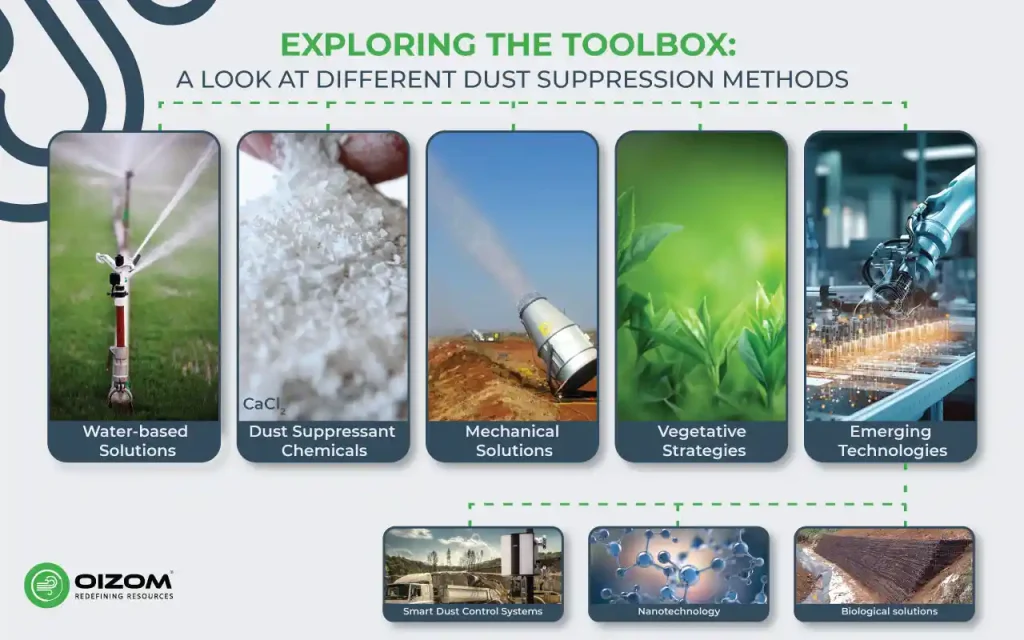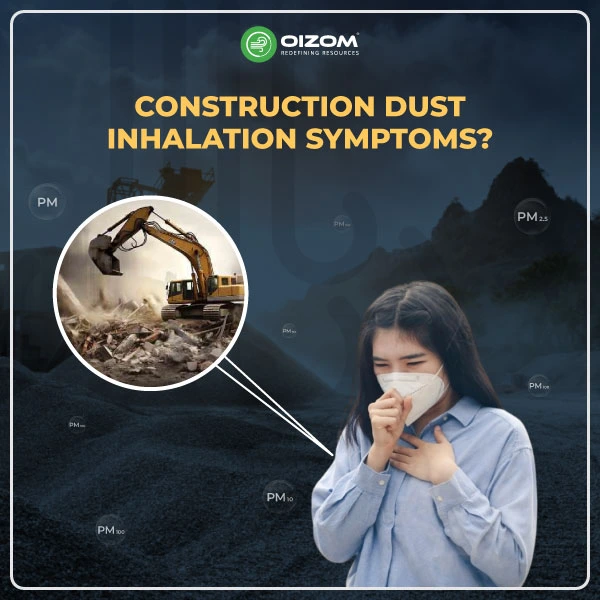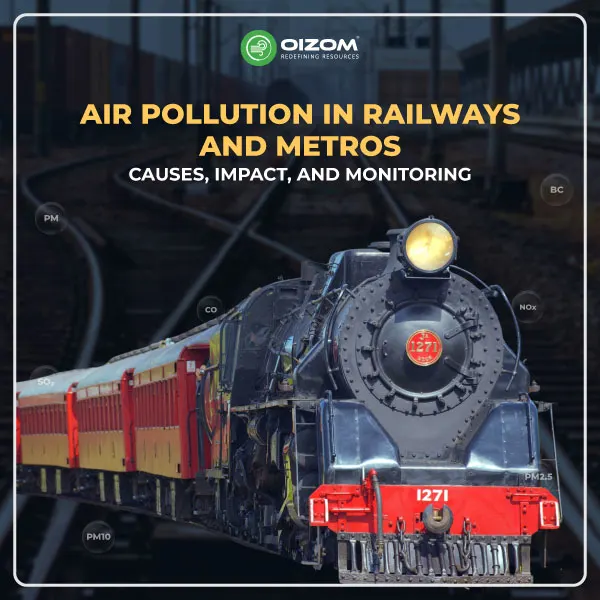Dust management is critical in industrial and construction environments for ensuring a safe and healthy atmosphere. Dust suppression and dust control are two popular techniques for dealing with dust-related concerns. While these terms are frequently used interchangeably, they refer to different approaches to managing airborne particles. Understanding the distinction between the two is critical when selecting dust control technologies and developing efficient strategies. This blog will delve deeper into the best dust suppression solutions for controlling dust with various suppression techniques. its procedures, and its significance. Let’s get started:
Why are dust suppression solutions important?
- Especially for those with heightened sensitivity or pre-existing conditions, it could exacerbate respiratory issues like asthma and bronchitis. Disturbingly, in more extreme circumstances, prolonged dust exposure might even peak the conditions as grave as lung cancer.
- Beyond individual health, dust’s broader implications encompass the environment. It has undesirable air quality and significantly reduces visibility. Anyone driving through a dust storm or thick haze can attest to the danger it presents, making activities hazardous.
- Specific environments amplify the urgency for dust suppression. Construction sites, mining zones, and agricultural fields become more dusty, and without proper management, they can transform into health risk zones for workers and the surrounding communities.
Key Factors to Consider before choosing the dust suppression solution.
Dust and airborne particles are common results of industrial activities. Effective dust suppression is critical in the rock, sand, gravel, and mineral processing sectors, where airborne dust can cause health dangers, equipment damage, and regulatory compliance issues. Fortunately, today’s dust suppression alternatives range from dry containment strategies to wet suppression technologies such as misting guns.
Selecting the appropriate dust suppression equipment ensures a safe and productive working environment. In this blog, we will look at the most important things to consider when choosing the best dust suppression equipment for your needs.
Application Area
Identifying the correct causes of dirt technology in your commercial operation is the first step in selecting the proper dust suppression gadget. Different tactics generate various types and portions of dust. Understanding these resources assists you in picking the right device to go to the troubled regions.
Dust Type
Not all dust is the same; home know-how is essential in selecting the perfect device. Dust debris’ size, density, and makeup decide how they scatter and settle. Carefully examining the dust will let you choose the only dirt suppression approach, including fogging systems, mist cannons, or dirt creditors.
Environmental Sensitivity
When purchasing a dust suppression system, environmental factors must be considered. Choose environmentally pleasant generation and water-based or filtration systems to ensure low emissions. Reducing the environmental effect of dirt suppression techniques is consistent with environmentally accountable commercial enterprise operations and regulatory compliance.
Cost and Effectiveness
While fine and efficacy are vital, budgetary limits must also be considered. Compare the initial buy price, renovation costs, and potential electricity usage of various dust suppression system alternatives. Strive for the proper stability of finances and performance to make an informed choice that fits your budgetary constraints.
Regulations and Permits
Worker safety is critical in every industrial setting. Select dust suppression equipment that meets with applicable authorities’ safety norms and regulations. Safety features such as automated shut-off systems, emergency stop buttons, and remote monitoring can improve overall operation safety.
Sustainability
Adopting sustainable dust suppression practices is essential. Organic options like lignosulfonate wood pulp derivatives offer a greener alternative. These biodegradable polymers are both cost-efficient and eco-friendly, aligning with the environmental consciousness of our times. Though more enduring and potent in dust suppression, synthetic polymers are an investment in longevity with a higher initial cost.
Ease of Application
Consider user-friendly solutions and require minimal training for efficient operation Because industries and processes are constantly changing, it is critical to select equipment that is flexible and adaptable. Consider adjustable nozzles, variable flow rates, and modular designs that can be readily integrated into your current setup or adapted for future expansion.
Safety Considerations
Safety must come foremost. The suppression solution should not add new risks. Wet systems require efficient drainage to eliminate slide dangers, while chemical suppressants necessitate defined safety standards and personal protective equipment. Always put worker safety first in your decision-making.
Exploring the Toolbox: A Look at Different Dust Suppression Methods
Dust suppression techniques aren’t a one-size-fits-all solution. It’s tailored, varied, and adaptive. Let’s explore some prevalent techniques:

Water-based Solutions
Water plays a quintessential role, often considered the first defence against dust. Moistening surfaces dust, preventing its release into the air. Moreover, misting systems use water to trap and cleanse the air of dust particles effectively.
Water can reduce dust in various ways; sprinkler systems can spread a moisturising net over large regions, such as construction sites, while water trucks give targeted moisture to smaller areas. Drip irrigation systems provide accurate water application in arid places where conservation is critical, ensuring that every drop serves the objective of dust suppression without waste.
Dust Suppressant Chemicals
A more specialized approach involves specific chemicals that either weigh down the dust or form protective films over it. By doing so, they ensure the dust remains grounded, thus preventing it from joining the atmospheric combination.
Calcium chloride, a hygroscopic salt, enjoys widespread use due to its cost-effectiveness and proficiency in dust reduction. Its counterpart, magnesium chloride, shares similar attributes but has a higher price tag and a marginally reduced dust control capability.
Mechanical Solutions
Mechanical dust control technologies include misting systems, cyclones, and bag houses installed at belt transfer locations. Most mechanical dust control methods require some type of automation, and as more mines transition to the digital era, mechanical dust control methods may be monitored in real-time.
Vegetative Strategies
Vegetative Buffers: Planting trees and shrubs alongside roads can trap dust particles. Vegetative cover reduces wind velocity at the ground surface, thus reducing the potential for dust to become airborne. Mulch is effective on sites that will reestablish vegetation and in areas where slopes have less than 1 foot of elevation change for every 2.5 feet of horizontal change. Mulch can be effective in areas with steep slopes in combination with tackifiers or other stabilization methods. Once established, vegetation can be more cost-effective for long-term stabilization.
Emerging Technologies
- Smart Dust Control Systems: represent the convergence of IoT, AI, and dust control technology. These systems can predict when and where dust emissions will likely occur and automatically adjust suppression methods accordingly. This predictive approach is far more efficient than traditional reactive methods.
- Nanotechnology: dust control involves using nanoparticles to capture dust particles or change the surface properties of areas prone to dust emission. These technologies promise minimal environmental impact and high efficiency but are still developing.
- Biological solutions: include bioengineering methods and natural dust-binding agents, offering an eco-friendly alternative to chemical suppressants. These methods use biological materials or processes to control dust, potentially reducing the ecological footprint significantly.
Conclusion
While dust suppression uses methods such as water sprays and chemical suppressants to reduce airborne particles, dust control uses chemical suppressants and other approaches to prevent dust formation and distribution. Property owners can efficiently manage dust, enhance air quality, and maintain a clean and safe environment for employees and visitors by selecting a suitable solution, such as dust management strategies such as enclosure systems or chemical suppressants for dust suppression.
Today, Advanced Technologies for dust suppression play a pivotal role in elevating these efforts, offering more efficient, sustainable, and automated solutions. By effectively controlling dust, these machines contribute to overall sustainability. However, monitoring the dust is more significant to plan such an effective strategy. Oizom dust monitors are robust and works on e-breathing technology, providing real-time monitoring and identifying dust parameters.
Expenses Associated with Dust Suppression:
- Equipment Costs: include purchasing specialized dirt suppression systems like misting structures, fog cannons, or sprinkler systems.
- Operational Costs: These are ongoing prices associated with the operation of dirt suppression structures, strength consumption and water usage.
- Maintenance Costs: Regularly renovate the device to ensure efficiency and durability.
- Chemical Costs: If chemical suppressants are used, there may be costs for purchasing and storing those chemical compounds.
- Training and Safety: Investment in school personnel to use and preserve dust suppression systems well and implement protection measures to defend employees.
Considerations for Dust Suppression in Mining Operations:
- Type of Mining Operation: Different mining operations (open-pit, underground, processing plants) have distinctive dust management needs.
- Environmental Factors: Local climate, wind styles, and topography can impact the effectiveness of dirt suppression techniques.
- Regulatory Compliance: Adhering to environmental and safety regulations related to air pollution and dust emissions.
- Impact on Equipment and Operations: Ensuring that dirt suppression strategies no longer negatively affect mining machinery or productiveness.
- Community Impact: Minimizing the effect of dirt on close by communities and ecosystems.
Maintenance for Efficient Dust Suppression: Maintenance frequency depends on the type of device and the operational surroundings. For example:
- Misting Systems: May require ordinary assessments for nozzle clogs and pump preservation.
- Chemical Suppressants: Periodic reapplication and storage checks.
Following the manufacturer's tips and modifying upkeep schedules is essential, primarily based on operational needs and environmental situations.
Dust Suppressant Chemicals and Application:
- Types of Chemicals: These can consist of water-soluble polymers, magnesium chloride, calcium chloride, and others, chosen primarily based on the particular desires of the operation.
- Application Methods: This can be carried out through spraying structures, incorporated into water vehicles, or used at the side of different dust management devices.
- Effectiveness and Safety: The effectiveness of these chemical substances depends on their utility charge, environmental situations, and the kind of dirt. Safety considerations encompass potential environmental impact and employee publicity.
For particular info and quality practices, consulting with dirt suppression experts or looking into enterprise-particular recommendations could be useful.






